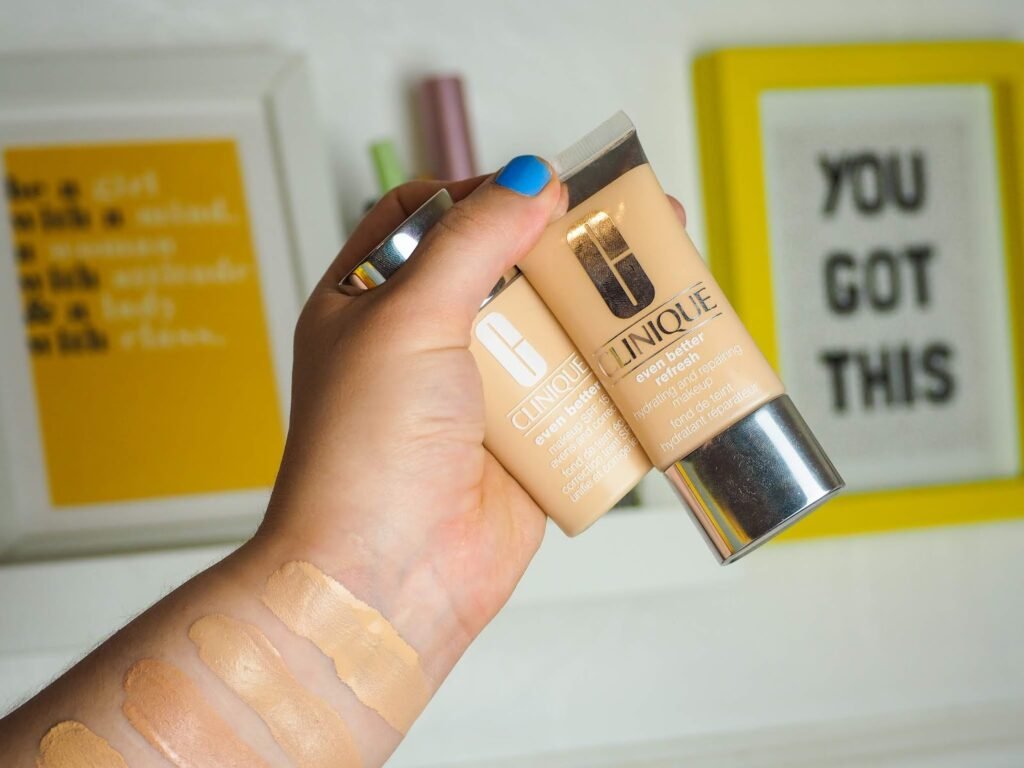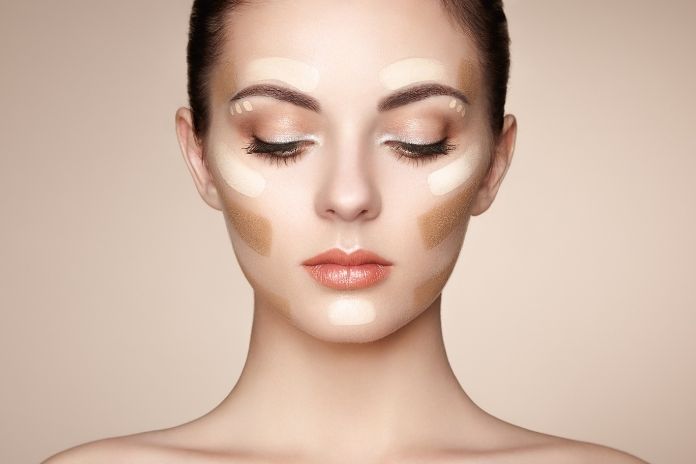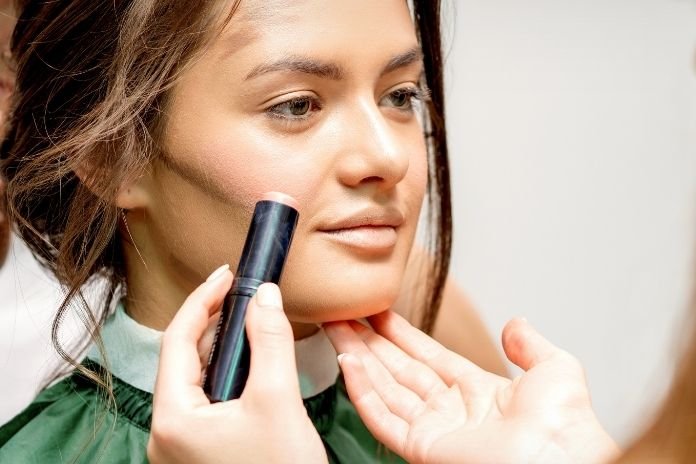Primer is a product used to prep the skin before applying foundation, while foundation is a cosmetic product used to even out skin tone and provide coverage. Primer and foundation are two key components in a makeup routine.
Primer creates a smooth canvas for foundation by filling in pores and fine lines, ensuring a flawless application. It also helps to extend the longevity of foundation. On the other hand, foundation provides coverage and evens out skin tone by hiding blemishes, redness, and imperfections.
It comes in various formulations, such as liquid, cream, powder, and mousse, allowing individuals to find their preferred texture and finish. Both primer and foundation work together to create a flawless base for further makeup application. Understanding the differences between these two products is essential in achieving a seamless and long-lasting makeup look.
Contents
- 1 Understanding Primer And Foundation
- 2 Key Differences Between Primer And Foundation
- 3 How Primer Prepares The Skin
- 4 Foundation: Achieving Flawless Complexion
- 5 Primer And Foundation: Relationship And Dependence
- 6 Choosing The Right Primer And Foundation
- 7 Common Mistakes To Avoid
- 8 Tips And Tricks For Primer And Foundation Application
- 9 Frequently Asked Questions
- 10 Conclusion
Understanding Primer And Foundation
Primer and foundation serve different purposes in makeup application. Primer helps to smooth out the skin texture and create a barrier between the skin and makeup, while foundation provides coverage and evens out the skin tone.
Primer and foundation are two essential products in the world of makeup, each serving a different purpose. While both are used to enhance the appearance and longevity of makeup, they have distinct characteristics that set them apart. In this section, we will delve into the key differences between primer and foundation.
So, let’s get started!
Overview Of The Importance Of Primer And Foundation In Makeup
Primer and foundation play crucial roles in achieving a flawless makeup look. Here’s a breakdown of why they are so important:
- Primer:
- Acts as a base: Primer creates a smooth canvas by filling in pores, fine lines, and imperfections. It preps the skin for foundation application.
- Enhances makeup longevity: By creating a barrier between the skin and makeup, primer helps to prevent product from slipping off or fading throughout the day.
- Controls oil and shine: Many primers are specifically formulated to mattify the skin, making it an ideal choice for those with oily or combination skin types.
- Provides color correction: Some primers come in different tints to counteract specific skin concerns, such as redness or sallowness.
- Foundation:
- Evens out skin tone: Foundation is designed to provide a uniform and even complexion by covering up blemishes, discoloration, and redness.
- Offers various coverage options: Foundations come in different formulations, ranging from sheer to full coverage, giving you the freedom to choose the level of coverage that suits your preferences.
- Provides a base for other makeup: Foundation acts as a base for other makeup products, such as blush, bronzer, and highlighter, helping them adhere to the skin seamlessly.
- Creates a natural-looking finish: Whether you prefer a luminous glow or a matte appearance, foundations are available in different finishes to cater to your desired look.
Understanding the purpose and benefits of primer and foundation is the first step to achieving a flawless makeup application. In the next section, we will explore each product in more detail, uncovering their unique characteristics and how to choose the right ones for your needs.
Stay tuned!

Key Differences Between Primer And Foundation
Primer and foundation have key differences that are worth noting. Primer acts as a base for makeup, filling in pores and creating a smooth canvas, while foundation provides coverage and evens out skin tone.
Primer and foundation are two essential cosmetics used in makeup routines, but they serve different purposes and offer distinct benefits. Understanding the key differences between primer and foundation can help you achieve a flawless makeup look. Let’s delve into the coverage and purpose, formulation and texture dissimilarities, and functionality and application disparities of each:
Coverage And Purpose Of Each:
- Primer: Primers are used as a base before applying foundation. They provide a smooth canvas for the foundation, ensuring a flawless finish. Primers primarily focus on blurring imperfections, reducing the appearance of pores, and creating a long-lasting makeup look. They offer minimal coverage and work like a mattifying or illuminating veil beneath the foundation, depending on your desired finish.
- Foundation: Foundations, on the other hand, offer varying degrees of coverage to even out skin tone and conceal blemishes. They come in different formulas such as liquid, powder, or cream, and can provide light to full coverage. Foundations are designed to give your skin a flawless appearance by evening out its texture and providing a base for other makeup products.
Formulation And Texture Dissimilarities:
- Primer: Primers usually have a lightweight, silky texture that glides smoothly onto the skin, creating a smooth base for the foundation. They contain silicone derivatives or oils that help fill in pores and fine lines, minimizing their appearance. Some primers may also contain ingredients like hydrating agents, antioxidants, or color-correcting pigments, catering to specific skin concerns.
- Foundation: Foundations have more diverse formulations and textures. Liquid foundations are the most common, providing a natural, buildable coverage. Powder foundations offer a lighter coverage and are suitable for oily or combination skin types. Cream foundations offer a heavier coverage and are ideal for those with uneven skin tone or blemishes. Each formulation differs in terms of finish, longevity, and suitability for specific skin types.
Functionality And Application Disparities:
- Primer: Primers act as a preparatory step for makeup application, creating a smooth canvas for foundation and other products. By extending the wear time of your makeup, primers help prevent oxidation and keep your makeup intact throughout the day. Applying primer after moisturizer and before foundation is the usual sequence.
- Foundation: Foundations are the core of makeup routines, providing coverage while maintaining a natural appearance. Their application can be tailored to your desired coverage level, and they can be layered for more opacity. Foundations should be applied evenly to the face using a sponge, brush, or fingertips, blending it into the skin for a seamless finish.
Understanding the differences between primer and foundation empowers you to select the appropriate products for your makeup routine. While primers focus on creating a long-lasting and smooth canvas, foundations offer coverage and help you achieve an even complexion. By utilizing both these essential products, you can enhance the longevity and appearance of your makeup.

How Primer Prepares The Skin
Primer is a product that prepares the skin for foundation application. While foundation provides coverage and evens out the skin tone, primer creates a smooth canvas by filling in pores and fine lines, allowing the foundation to adhere better and last longer.
Additionally, primer can also control oil, minimize shine, and blur imperfections, providing a flawless finish.
Role Of Primer In Creating A Smooth Canvas
- Primer plays a crucial role in creating a smooth canvas for flawless makeup application.
- It acts as a base for foundation, helping to fill in fine lines, pores, and imperfections on the skin’s surface.
- By creating a smooth surface, primer allows foundation to glide on effortlessly, resulting in a more even and polished finish.
Benefits Of Using Primer Before Foundation Application
Using primer before applying foundation offers several benefits:
- Increased longevity: Primer helps to extend the longevity of your makeup by creating a barrier between your skin and the foundation. This barrier prevents oils from seeping into the foundation, causing it to break down or separate throughout the day.
- Improved texture: Primer helps to blur the appearance of fine lines, wrinkles, and pores, giving your skin a smoother and more refined texture. This creates a perfect base for foundation, allowing it to sit more evenly on the skin.
- Enhanced makeup adherence: Primer helps foundation adhere better to the skin, preventing it from settling into creases or fading throughout the day. This ensures that your makeup stays in place for longer, without the need for frequent touch-ups.
- Color correction: Certain primers come with color-correcting properties that help neutralize unwanted undertones or discolorations on the skin. Green-toned primers, for example, can counteract redness, while purple-toned primers can help brighten dull complexions.
How Primer Helps Extend Makeup Longevity
- Creates a barrier: Primer forms a protective barrier between the skin and foundation, preventing oils and moisture from seeping into the foundation. This helps to prevent your makeup from creasing, fading, or flaking throughout the day.
- Controls oil production: Some primers are specifically designed to control excess oil production, keeping shine at bay and ensuring that your foundation stays in place for longer.
- Locks in moisture: Certain primers contain hydrating ingredients that help lock in moisture, keeping your skin hydrated throughout the day. This not only helps your foundation look more natural, but it also prevents it from clinging to dry patches.
- Acts as a base: Primer acts as a base for your foundation, helping it adhere better to the skin. This ensures that your makeup stays put and doesn’t slide off, even under challenging conditions like humidity or sweat.
- Prevents caking: By providing a smooth surface, primer helps prevent foundation from clumping or caking, allowing for a more seamless and natural-looking finish.
Using primer before applying foundation is a game-changer in achieving flawless makeup. Not only does it create a smooth canvas for foundation application, but it also helps extend the longevity of your makeup. By understanding the role that primer plays in preparing the skin, you can achieve a flawless and long-lasting makeup look that stays fresh throughout the day.
Foundation: Achieving Flawless Complexion
Primer and foundation serve different purposes in achieving a flawless complexion. While primer creates a smooth canvas for makeup application, foundation provides coverage and color correction for a seamless look. Understanding the differences between the two can help you choose the right product for your needs.
Foundation is an essential makeup product that helps create a flawless complexion. It acts as a base for your entire makeup application, providing coverage and evening out the skin tone. Whether you want to achieve a natural, everyday look or a more glamorous appearance, choosing the right foundation is crucial.
Exploring The Primary Purpose Of Foundation:
- Foundation is designed to even out your skin tone and provide a smooth canvas for the rest of your makeup.
- It helps to hide imperfections such as blemishes, redness, and pigmentation, giving you a more polished and flawless look.
- Foundation also plays a vital role in creating a long-lasting makeup base, helping your makeup stay put throughout the day.
- Moreover, foundation can offer added benefits like sun protection, hydration, and oil control, depending on the formulation you choose.
Different Types Of Foundation Formulations:
There are several types of foundation formulations available in the market, each with its own unique features and finishes. Here are the main types you can consider:
- Liquid foundation: This is the most popular and versatile formulation. It comes in various finishes, ranging from sheer to full coverage, and offers a natural-looking result.
- Cream foundation: Cream foundations are thicker and provide more coverage than liquid foundations. They are suitable for those with drier skin or those who prefer a heavier base.
- Powder foundation: Powder foundations are lightweight and ideal for oily or combination skin types. They offer buildable coverage and a matte finish.
- Stick foundation: Stick foundations are compact and travel-friendly. They provide medium to full coverage and are easy to blend, making them great for touch-ups on the go.
- Tinted moisturizer: Tinted moisturizers are lighter in coverage and offer a more natural, dewy finish. They are perfect for those who prefer a minimal makeup look or have dry skin.
Finding The Right Foundation Shade For Your Skin Tone:
Choosing the right foundation shade is crucial to achieve a seamless, natural look. Here are some tips to help you find the perfect match for your skin tone:
- Determine your undertone: Identify whether your undertone is warm, cool, or neutral. Warm undertones have hints of yellow or peach, cool undertones have pink or blue undertones, while neutral undertones have a balance between warm and cool.
- Test the shade in natural light: Always swatch the foundation on your jawline or the side of your face in natural light. This will ensure the color blends well with your skin and avoids any harsh lines.
- Consider your skin type: Depending on your skin type, you may prefer a matte, dewy, or satin finish foundation. Keep in mind that oily skin types may require oil-free or mattifying foundations, while dry skin types may benefit from hydrating formulas.
- Seek professional assistance: If you’re unsure about your shade or undertone, consider visiting a makeup counter where experts can assist you in finding the right foundation match.
Now that you have a better understanding of foundation and its purpose, formulation options, and shade selection, you can confidently choose the right foundation to achieve a flawless complexion. Remember, the key is to find a foundation that not only matches your skin tone but also caters to your specific needs and preferences.
So go ahead and rock the perfect base for your makeup looks!

Primer And Foundation: Relationship And Dependence
Primer and foundation play different roles in makeup application. Primer creates a smooth canvas, while foundation provides coverage and evens out the skin tone. Understanding the differences between these two products is crucial for achieving a flawless complexion.
How Primer And Foundation Work Together:
- Primer and foundation are both essential makeup products that work hand in hand to create a flawless and long-lasting finish. They have distinct roles but are interdependent in achieving the desired effect.
- Primer acts as a preparatory step before foundation application, ensuring a smooth canvas for makeup. It fills in pores, wrinkles, and fine lines, creating a uniform texture on the skin surface.
- Foundation, on the other hand, provides coverage and evens out the skin tone, concealing imperfections and creating a uniform complexion.
- When applied together, primer creates a base for foundation, allowing it to adhere better and last longer throughout the day.
- Primer also helps minimize the appearance of pores and fine lines, making the foundation application appear more flawless and natural.
- While primer prepares the skin and enhances the foundation’s performance, foundation provides the coverage and color correction, with both products working together to achieve a seamless and polished look.
Can Foundation Be Skipped If Using A Primer?
- While primer can help improve the appearance and lifespan of foundation, it cannot entirely replace its purpose.
- Foundation plays a crucial role in providing coverage and evening out the skin tone, making it an indispensable part of most makeup routines.
- While some people with naturally flawless skin may choose to skip foundation and rely solely on a primer, for those who want to conceal imperfections or achieve a specific desired look, foundation remains essential.
- Primer alone may not offer enough coverage to hide blemishes, redness, or other skin concerns that foundation effectively addresses.
- Therefore, while a primer can enhance the foundation’s performance, it is not a substitute for foundation itself. The choice to skip foundation ultimately depends on an individual’s personal preferences and desired level of coverage.
Enhancing Foundation With Primer For A Better Finish:
- When used in combination with foundation, a primer can significantly improve the overall finish and longevity of your makeup.
- Primer acts as a base, helping the foundation adhere to the skin and preventing it from sliding or fading throughout the day.
- By filling in pores, fine lines, and uneven texture, primer creates a smoother surface, allowing the foundation to glide on seamlessly.
- Primer can also help control excess oil production, preventing the foundation from becoming shiny or settling into creases and wrinkles.
- Additionally, certain primers come with added benefits, such as color correction or added hydration, which can enhance the foundation’s performance and result in a more flawless complexion.
- By using a primer in conjunction with foundation, you can achieve a more polished and long-lasting makeup application, with a smoother appearance and improved adherence.
Remember, primer and foundation work together to create a flawless and long-lasting makeup look. While primer prepares the skin and enhances the foundation’s performance, foundation provides the coverage and color correction. By using a primer, you can enhance the foundation’s finish and longevity, but it cannot entirely replace the purpose of foundation itself.
Choosing The Right Primer And Foundation
Primer and foundation serve different purposes. While primer creates a smooth and even base for makeup, foundation provides coverage and evens out skin tone. Understanding their differences helps in choosing the right products for a flawless makeup look.
To achieve a flawless makeup look, it is essential to choose the right primer and foundation that suit your skin type, texture, and desired finish. Understanding these factors will help you achieve optimal results and ensure that your makeup lasts all day.
Let’s dive into each aspect in detail:
Understanding Skin Type And Texture
Determining your skin type and texture is crucial when selecting the right primer and foundation. Here are some key points to consider:
- Dry skin: Look for hydrating primers and foundations that provide moisture and prevent flakiness. Opt for liquid or cream-based formulas that offer a dewy finish.
- Oily skin: Seek oil-controlling primers and oil-free foundations to combat excess shine. Matte or powder formulations are ideal for a long-lasting, shine-free look.
- Combination skin: Choose a primer that addresses both dry and oily areas of your face. For foundation, consider a lightweight formula that balances moisture and controls shine.
- Normal skin: Lucky you! You can experiment with a wide range of primers and foundations as your skin is relatively balanced. Opt for formulas that suit your desired finish.
Considering The Desired Makeup Finish
The finish you desire plays a vital role in choosing the right primer and foundation. Here are the options you can explore:
- Dewy finish: If you prefer a luminous, radiant look, opt for a hydrating or illuminating primer. Pair it with a foundation that offers a natural or satin finish for a healthy glow.
- Matte finish: For a shine-free, velvety complexion, select a mattifying primer and a matte foundation. These formulas are excellent for controlling oil and providing a long-lasting, matte finish.
- Natural finish: If you want your makeup to look like your own skin but better, go for a primer that blurs imperfections and a lightweight foundation with a natural or semi-matte finish.
Matching Primer And Foundation Formulations For Optimal Results
To achieve the best outcome, it’s important to match the formulations of your primer and foundation. Here’s what to consider:
- Water-based primer with water-based foundation: These formulations work well for most skin types and allow for even application and a comfortable feel.
- Silicone-based primer with silicone-based foundation: Ideal for filling in pores, fine lines, and creating a smooth base. This combination provides a flawless, long-lasting finish.
- Oil-based primer with oil-based foundation: Suitable for drier skin types as it provides added hydration and a dewy finish.
- Powder primer with powder foundation: Perfect for oily skin types, as both products help to control excess oil and maintain a matte finish.
Remember, it’s essential to test different products and combinations to find the perfect primer and foundation for your unique needs. Consider consulting with a makeup professional or sampling products before making a purchase. With the right primer and foundation, you can achieve a flawless and long-lasting makeup look tailored to your preferences and skin type.
Common Mistakes To Avoid
Primer and foundation are two essential makeup products, but they serve different purposes. Primer is used to prep the skin and create a smooth surface for foundation, while foundation is used to even out skin tone and provide coverage. Avoid mistaking one for the other and make sure to use them in the correct order for a flawless complexion.
Overusing primer or foundation:
- Using too much primer can make the skin feel heavy and greasy, and it may cause the foundation to appear cakey or settle into fine lines.
- Applying an excessive amount of foundation can result in a heavy and unnatural look, and it may emphasize pores and wrinkles.
Incorrect application techniques:
- Using fingers to apply primer or foundation can lead to uneven coverage and streaks.
- Applying foundation without properly blending can leave visible lines or patches of skin with different shades.
Failing to blend primer and foundation properly:
- Not blending the primer into the skin adequately can cause an uneven base and make the foundation application appear patchy.
- Neglecting to blend the foundation properly can result in an uneven skin tone and visible demarcation lines.
Remember, achieving a flawless makeup look requires attention to detail and avoiding these common mistakes. Take note of the following recommendations to ensure a smooth and seamless application:
- Use primer sparingly by applying a pea-sized amount across your face, focusing on areas with noticeable pores or texture.
- Apply foundation in small dots across your face and blend it outwards using a makeup brush or sponge for a natural and even finish.
- Take time to blend the primer and foundation together at the edges of your face, such as the jawline, hairline, and neck, to avoid noticeable lines.
- Always start with a light layer and build up coverage gradually, allowing you to achieve a natural and radiant look.
- Pay attention to areas that require extra coverage, such as blemishes or dark circles, by using a concealer or color corrector before applying foundation.
By following these tips, you can avoid the common mistakes of overusing primer or foundation, applying them incorrectly, and failing to blend them properly. This will result in a flawless and natural-looking base for your makeup application.

Tips And Tricks For Primer And Foundation Application
Looking for tips and tricks on primer and foundation application? Learn the differences between primer and foundation to achieve flawless makeup results. Discover the secrets to a flawless base for your makeup routine.
Step-By-Step Guide To Applying Primer And Foundation:
- Begin by ensuring that your face is clean and moisturized.
- Apply a small amount of primer to your fingertips or a makeup brush, and gently spread it all over your face.
- Use upward, circular motions to help the primer absorb into your skin.
- Pay special attention to areas with visible pores or fine lines, as primer helps to create a smooth canvas for your foundation.
- Once the primer has been applied, allow it to set for a few minutes before moving on to the foundation.
- Choose a foundation that matches your skin tone and type.
- Apply a small amount of foundation to the back of your hand or a makeup palette.
- Use a damp makeup sponge, brush, or your fingers to apply the foundation evenly to your face.
- Start at the center of your face and blend outward for a natural look.
- Use patting or stippling motions for a full-coverage finish, or swipe motions for a lighter coverage.
- Blend the foundation down your neck to avoid any harsh lines.
- Set your foundation with a light dusting of setting powder or setting spray to ensure that it stays in place throughout the day.
Ways To Ensure A Seamless Blend:
- To achieve a seamless blend between your primer and foundation, follow these tips:
- Make sure that both products are well-matched to your skin type and tone.
- Use a foundation brush or makeup sponge to blend the foundation into your skin, focusing on areas that require more coverage.
- Take your time blending the foundation in circular motions for a flawless finish.
- Be sure to blend the foundation into your hairline, jawline, and neck to ensure a seamless transition.
- Use a damp sponge to pat and blend any excess product into your skin for a natural look.
Long-Lasting Tricks And Tips For Primer And Foundation Wear:
- To make your primer and foundation last all day, try these long-lasting tricks:
- Apply a thin layer of primer and allow it to fully dry before applying foundation. This will create a smooth base and help your foundation stay put.
- Use a primer specifically designed for long-lasting wear, such as a mattifying primer for oily skin or a hydrating primer for dry skin.
- Set your foundation with a dusting of translucent powder or a spritz of setting spray to lock it in place.
- If you have oily skin, consider using an oil-absorbing primer or blotting papers throughout the day to control shine and keep your foundation looking fresh.
- Avoid touching your face throughout the day to prevent your foundation from rubbing off.
Troubleshooting Application Or Selection Issues
- Why does my foundation look cakey?
- Cakey foundation can be the result of using too much product, improper blending, or applying it on dry skin. Make sure to moisturize well, use a lighter hand while applying, and blend thoroughly.
- How can I find the right shade of foundation?
- To find the perfect shade, swatch a few options on your jawline and choose the one that seamlessly blends in with your natural skin tone. Natural lighting is best for color matching.
- What can I do if my primer causes breakouts?
- If a primer causes breakouts, try switching to a different formula or a non-comedogenic primer that is less likely to clog pores. Cleanse your face thoroughly before applying.
- How do I prevent my makeup from creasing?
- To prevent creasing, apply a thin layer of primer, use a setting powder, and avoid excessive product application. Also, avoid rubbing or touching your face excessively throughout the day.
Expert Advice For Primer And Foundation Usage
- Should I use a different primer for different foundations?
- It is not necessary to use a different primer for each foundation. However, certain primers may work better with specific foundation formulas or address particular skin concerns.
- Can I mix a primer and foundation together?
- Mixing a primer and foundation can alter their consistency and performance. It is generally recommended to apply them separately for better control over coverage and finish.
- How can I make my foundation last longer?
- To make your foundation last longer, ensure proper skincare, use a primer, set with a translucent powder, and consider using a setting spray. Blotting papers can also help control excess oil.
- Do I need to use a primer and foundation every day?
- Using a primer and foundation is a personal choice. Some prefer to use them daily for a polished look, while others prefer a more natural appearance or may skip them on certain occasions.
Remember, primer and foundation work together to enhance the longevity and finish of your makeup. By addressing common queries, troubleshooting application or selection issues, and providing expert advice, you can make the most out of these versatile cosmetics. So, go ahead and create a flawless canvas for your makeup skills to shine!
Frequently Asked Questions
Do I Need Both Primer And Foundation?
Yes, you need both primer and foundation for a flawless makeup application.
Is It Better To Use Foundation Or Primer?
Primer is better to use before applying foundation. It creates a smooth base, helps makeup last longer, and minimizes pores.
Can You Use Primer As A Foundation?
No, primer should not be used as a foundation.
Can I Use Face Primer Instead Of Foundation?
No, face primer cannot be used as a substitute for foundation.
Conclusion
To sum up, understanding the differences between primer and foundation is crucial for achieving a flawless makeup look. While both products serve different functions, they work hand in hand to enhance the overall appearance of the skin. Primer acts as a smooth canvas that preps the skin, minimizing pores and fine lines.
It also helps in increasing the longevity of makeup application. On the other hand, foundation provides coverage to even out the skin tone and conceal imperfections. It comes in various formulations, catering to different skin types and desired finishes. It is important to select the right shade and formula to achieve a natural and seamless look.
By incorporating primer and foundation into your makeup routine, you can create a long-lasting and flawless base for any desired makeup look. So, remember to invest in both primer and foundation to elevate your makeup game to the next level.
